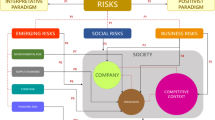Abstract
This study describes a critical assessment of the risk control decision model from a methodological perspective and identifies major shortcomings with the employment of enhanced formal evaluation and decision-making methods. This in turn could have major applications for natural disaster risk control. The methodology follows the description of interpretive structural modeling (ISM), which is an interactive learning process in which a set of different and directly related elements is structured to form a comprehensive systemic model. The next step explores the potentials of different mathematical programming approaches in order to improve decision making, i.e., for the development of an economic utility constrained-maximization model that addresses the issue of optimal budget allocation under a trade-off framework. Several aspects of risk and uncertainty are discussed within the context of an economic utility constrained-maximization model with a major focus on the importance of risk and uncertainty in research evaluation, and how the strategy determines the insurance and risk control plans.


Similar content being viewed by others
References
Agarwal, Ashish, Shankar R, Tiwari M (2007) Modeling agility of supply chain. Ind Mark Manag 36(4):443–457
Bar-Hillel M (1980) The base rate fallacy in probability judgments. Acta Psychol 44:211–233
Bolanos R, Fontela E, Nenclares A, Paster P (2005) Using interpretive structural modeling in strategic decision making groups. Manag Decis 43(6):877–895
Handfield RB, Bechtel C (2002) The role of trust and relationship structure in improving supply chain responsiveness. Ind Mark Manag 31:367–382
Haque CE, Etkin D (2007) People and community as constituent parts of hazards: the significance of societal dimensions in hazards analysis. Nat Hazards 41(2):271–282
Jharkharia S, Shankar R (2005) IT-enablement of supply chains: understanding the barriers. J Enterp Inf Manag 18(1):11–27
Katayama H, Bennett D (1999) Agility, adaptability and leanness: a comparison of concepts and a study of practice. Int J Prod Econ 60–61:43–51
Mandal A, Deshmukh SG (1994) Vendor selection using interpretive structural modeling (ISM). Int J Oper Prod Manag 14(6):52–59
Power DJ, Sohal AS, Rahman S (2001) Critical success factors in agile natural disaster risk management: an empirical study. Int J Phys Distrib Logist 31(4):247–265
Prater E, Biehl M, Smith MA (2001) International natural disaster risk control tradeoffs between flexibility and uncertainty. Int J Oper Prod Manag 21(5/6):823–839
Raaijmakers R, Krywkow J, van der Veen A (2008) Flood risk perceptions and spatial multi-criteria analysis: an exploratory research for hazard mitigation. Nat Hazards 46(3):307–322
Ravi V, Shankar R (2005) Analysis of interactions among the barriers of reverse logistics. Technol Forecast Soc Change 72:1011–1029
Sage AP (1977) Interpretive structural modeling: methodology for largescale systems. McGraw-Hill, New York
Saxena JP, Sushil, Vrat P (1990) The impact of indirect relationships in classification of variables—a MICMAC analysis for energy conservation. Syst Res 7(4):245–253
Sharma HD, Gupta AD, Sushil (1995) The objectives of waste management in India: a future inquiry. Technol Forecast Soc Change 48:285–309
Singh MD, Shankar R, Narain R, Agarwal A (2003) Knowledge management in engineering industries—an interpretive structural modeling. J Adv Manag Res 1(1):27–39
Waddell D, Sohal AS (1998) Resistance: a constructive tool for change management. Manag Decis 36(8):543–548
Warfield JW (1974) Developing interconnected matrices in structural modeling. IEEE Transcr Syst Men Cybern 4(1): 51–81
Yi CS, Lee JH, Shim MP (2010) GIS-based distributed technique for assessing economic loss from flood damage: pre-feasibility study for the anyang stream basin in Korea. Nat Hazards 55(2):251–272
Yusuf YY, Gunasekaran A, Adeleye EO, Sivayoganathan K (2004) Agile natural disaster risk capabilities: determinants of competitive objectives. Eur J Oper Res 159:379–392
Zhou HJ, Wang JA, Wan JH et al (2010) Resilience to natural hazards: a geographic perspective. Nat Hazards 53(1):21–41
Author information
Authors and Affiliations
Corresponding author
Rights and permissions
About this article
Cite this article
Tseng, CP., Chen, CW. & Tu, YP. A new viewpoint on risk control decision models for natural disasters. Nat Hazards 59, 1715–1733 (2011). https://doi.org/10.1007/s11069-011-9861-1
Received:
Accepted:
Published:
Issue Date:
DOI: https://doi.org/10.1007/s11069-011-9861-1




